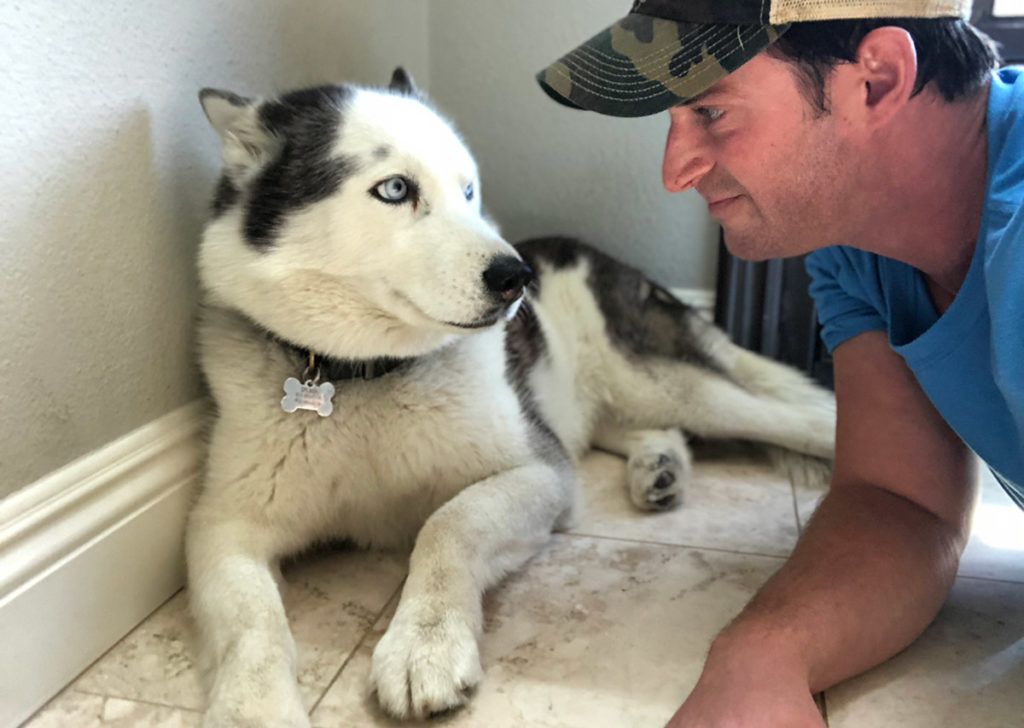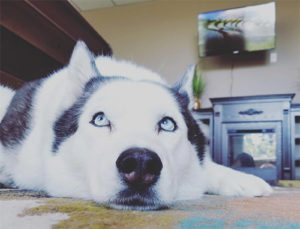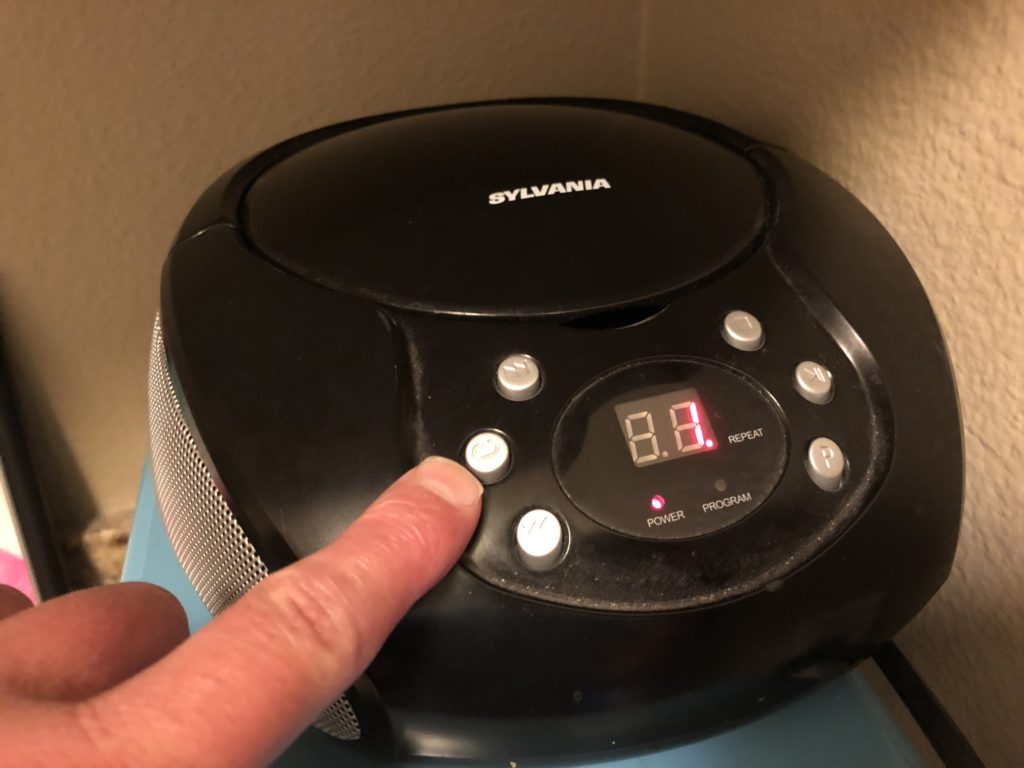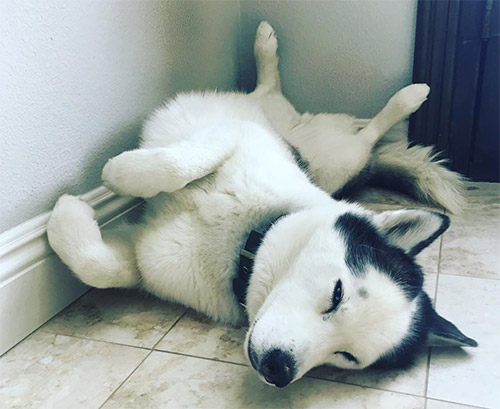
Curing Dog Separation Anxiety Quickly
First off, if you’re reading this, you’re probably going through the excruciating process of dealing with canine separation anxiety. I know how hard this is. And I want you to know one thing: you can beat it.
The process I am going to share here contains pieces of advice you will hear other places, but also few very unique things that I stumbled upon that finally beat separation anxiety for good. In fact, I’ve shared this story with both dog trainers and veterinarians, and the response is always the same: “You did what?! I’m telling my clients to try that!”
Second, know that separation anxiety is not your fault. It’s also not your dog’s fault. Separation anxiety is often the result of your dog’s environment before they came to you. Or sometimes a dog develops separation anxiety for no apparent reason or past trauma. We simply don’t know all the reasons. But there is hope.
My Story: Shelter Dog Separation Anxiety
Meet Splash, my now 12 year old Siberian Husky rescue. Splash came to live with us 10 years ago after she was found wondering around in the mountains here in Southern California. She had no tags or microchip. I don’t know her story.
Splash was a mostly normal Siberian Husky. She liked being around people, but for the most part had no trouble being left alone in our home.
About 6 years after we adopted her, something changed. Oftentimes you hear about traumatic events that trigger separation anxiety, like a change in living situation or a move. But there was nothing like that.
Related: 10 Best Calming Supplements for Your Dog
All of a sudden we would come home to find her panting with drool all over the floor. That was how it started, and it was mildly annoying but not yet overly concerning. Then came the destruction.
Splash is a very agile dog, and she started jumping up on counters and knocking things over.
Then, she tore through our new plantation shutters. Ka-ching, the bills started piling up.
We tried leaving her in our backyard, thinking that would minimize the damage inside the house. But she soon learned to escape. She would scale our 6 foot concrete fence walls and get out into the neighborhood. It got so bad that I had to attach a GPS locator to her collar.
Curing Dog Separation Anxiety – What Didn’t Work
I began doing my homework on what things might help calm an anxious dog with separation anxiety.
First, I tried leaving her with things to do. I put out toys, treats, and chews to keep her busy. These didn’t work at all, because once her anxiety kicked in, she lost all interest in playing or even her food drive.
We tried exercising her vigorously before leaving but that didn’t seem to have an effect.
We tried the calming wraps like the Thundershirt, and those didn’t work.
We tried pheromone based diffusers. Didn’t work.
We tried training various crates and kennels. We tried to warm her up to them and make them a very positive experience. But all attempts failed.
The Short Lived Victory Of Fixing Separation Anxiety In Dogs
After a trip to the vet, and my extreme frustration, my veterinarian at the time suggested medication. Prozac, specifically. He warned me, however, that if this worked Splash would NEVER be able to stop taking the drug. This concerned me, and I also had reservations about side effects, but I was at my wits’ end. I loved my dog. I didn’t want her to become a statistic, another owner surrender at a shelter. I was willing to give the medication a shot.
At 2 days into her taking the medication, I noticed a change. She didn’t seem to care being away from us, or seeing us leave. In fact, she didn’t seem to care much about anything at all.
After a few more days, and it became clear that the medication was having a calming effect. However, I noticed her behavior also began to change. She lost her spunky personality, and much of her former energy. She slept more, and was far less interest in play or interacting with our family.
But… we were finally able to leave the house. We would come home and she was just fine. I thought we had finally beat this. Or so I thought.
The First Piece of The Puzzle
Around this time, at the advice of several dog trainers I began to learn about the concept of desensitization. Here’s the basic idea:
Before you even leave your house, your dog knows what’s going to happen. Dogs are incredibly intelligent and easily pick up on the queues. Grabbing your keys. Putting on your shoes. Getting dressed. These are all signs you’re heading out the door.
For a dog with separation anxiety, these signals eventually become the triggers of the anxiety itself. In other words, your dog begins to fear you grabbing the keys just as much as you being gone.
The key is to teach them that these signals DO NOT mean you’re leaving. You have to desensitize them to these behaviors.
For example, you pick up your keys and put them in your pocket or purse, then go sit down on the couch.
You put on your shoes, and walk over and sit down and pet your dog.
You walk out the door, and quickly walk back in and greet your pup.
Desensitization is a process that takes many days or even weeks of work and isn’t a one time thing.
Even before I began her on medication, I began to work on desensitization with Splash, and noticed that she became far less anxious when I was leaving. It wasn’t a cure by any means, but it began to help.
The Extreme Separation Anxiety Returns… with Vengeance
After about 9 months on the medication and desensitization, the signs of separation anxiety began to slowly re-emerge. The panting. The drooling. And slowly but surely, the destruction.
It began to wreak havoc on our family’s life again. We couldn’t leave the house for long without her working herself into a panic.
One day, at the peak of our frustration, I was working from home and had to take a long phone call. I was home alone with Splash and was concerned she would begin to panic if I disappeared into my office for an hour.
After the call, I opened the door expecting the worst. But there she was at my feet, asleep right by the door. Then all at once, it hit me!
The Epiphany
I realized that if Splash believed I was home, she didn’t seem to care that she couldn’t see me. I realized that while I was in my office, she could hear my voice talking on the phone, and smell me under the door.
I asked myself, how can I make her feel like I’m home even when I’m not?
On a whim, I decided to try something crazy. I popped open a voice recorder on my computer and recorded myself speaking. Nothing in particular, I just rambled off on anything and everything, almost like I was on a phone call.
Then I bought a simple old fashion CD player with a loop function. Then I burned a CD with this 5 minute recording of myself speaking.
The next day was Super Bowl Sunday, and my family had been invited to our friend’s house for the afternoon. This is my chance to try this, I thought.
As we left the house, I walked out the door and hit play on the CD player which I had placed inside our garage, making sure the repeat function was set so that it would loop my voice over and over. I also took a t-shirt I had wore the previous day and placed it right outside the door so she could smell my scent. Nervously, we left for the party.
After about 2 hours, I couldn’t take the suspense. At halftime, I left the party and went home to check on Splash. I opened the door expecting the worst… but there she was asleep on the ground by the door! She barely noticed me. IT WORKED!
Victory At Last… But Just One Small Problem

Today, every time I walk out of the house I hit play on that CD player. I’ve been using the same 5 minute recording of my voice for over 3 years now.
I also still work on desensitization from time to time. Basically, my goal is to never fall into a routine where we leave the house using the same signals, alerting Splash to our leaving.
While we had finally beat the separation anxiety, there was still one lingering issue: The side effects of the medication.
One day I was working with a dog trainer who was working with Splash on some other things not related to anxiety. He commented that she seemed a bit dull and unresponsive to training. I told him about the Prozac, and he asked me whether or not I had tried full spectrum Hemp oil for dogs.
I had heard things about Hemp oil being good for anxiety, but didn’t believe I would be able to take Splash off her medication without serious issues.
After talking with my vet, I decided to give it a try. I could always put her back on the drug, I thought.
I began giving her Hemp oil, and stuck to my usual process. I would always play the CD when I left, and still worked on desensitization from time to time.
To my great surprise after several weeks off the medication and taking Hemp oil, she continued to have no separation anxiety.
But there was one added benefit, my spunky husky returned! Now off the medication, Splash began acting like her old self before the anxiety issues. She was smarter, more playful, more interested in interacting with our family, and far more trainable. I had my old dog back!
My Long Term Solution For Severe Separation Anxiety In Dogs

To this day I still play the CD player recording of my voice every time I leave the house. I also work on desensitization on occasion, maybe once a month.
I don’t give her Hemp oil every day, but I will give it to her when we’re leaving for longer periods of time, just in case. (Hemp is also helpful for other anxiety issues, it works great for Splash during 4th of July fireworks or thunderstorms. The brand I use is Cannanine)
It’s been 3 years now since she has shown any signs of separation anxiety. I have my dog back–and my life back!
Related Post: The Complete Guide to Hemp Oil for Dogs
How To Cure Separation Anxiety In Dogs – My Advice
Know that the cure for separation anxiety is a process that will likely involve many components. Unfortunately, there might not be one magic silver bullet, it might be a combination of things like what I revealed in my story.
If you’re battling separation issues with your pup, I hope my story has given you some hope. My solution may not be the exact solution for your dog, but I hope some of the tips and tricks will help. Keep at it, and never give up. Your dog is worth it!
Has this advice helped you? Is there any other way I can help? Feel free to reach out to me at justin[at]homelifemedia.com
Frequently Asked Questions:
While it sounds nice to be able to cure your dog’s mental health in just a few days or weeks, you have a challenge ahead of you. Curing a dog of separation anxiety takes time, patience, and effort. Unfortunately, no one has discovered a way to quickly train a dog out of their anxiety, but you can reduce their anxiety without a bit of process. Learn the steps to the process here and start creating a better life for you and your dog.
How Do I Fix Separation Anxiety In My Dog Fast?
Curing dog separation anxiety quickly can be challenging, if not impossible, as it requires a lot of time, patience, and consistent training. However, there are some things you can do to help your dog cope with separation anxiety more effectively.
Gradual desensitization: Start by leaving your dog alone for short periods and gradually increase the time.
Provide plenty of exercises: Ensure that your dog gets plenty of exercises daily to burn off energy and help with anxiety.
Create a safe space: Give your dog a place that’s all their own such as a cozy dog bed in a corner just for them.
Use calming aids: Consider using calming aids, such as pheromone sprays or music designed to calm dogs, to help reduce your dog’s anxiety. CBD can work wonders for dogs’ anxiety.
Reward good behavior: When your dog behaves well when you are away, reward them with treats or praise.
How Long Does It Take To Break A Dog From Separation Anxiety?
The time it takes to break a dog from separation anxiety can vary depending on the severity of the anxiety and the dog’s individual temperament and training history. In some cases, it can take several weeks or even months of consistent training and behavior modification to see significant improvements in a dog’s separation anxiety.
However, with patience, consistency, and the right training techniques, many dogs can learn to manage their separation anxiety over time. If possible, work closely with a professional dog trainer to develop a tailored plan that addresses your dog’s specific needs and helps them overcome their anxiety. Dedicating the time now to help your dog can save you both years of frustration.
Should You Crate A Dog With Separation Anxiety?
Crating a dog with separation anxiety can be a helpful tool in managing their anxiety, but it’s not always the best solution for every dog. If your dog is not used to being in a crate or has had negative experiences with crating in the past, it may not be the best option for them. Ensure the crate is a positive and comfortable space for your dog.
How Do I Train My Dog To Be Alone?
Training your dog to be alone should be a gradual process that involves positive reinforcement, patience, and consistency. Start with small durations of separation and give them a safe space to be alone. Always use positive reinforcement to create a positive learning experience.
Next, consider adding exercise to your dog’s morning routine. When they exercise before you leave for the day, they are more likely to want to nap instead of whining at the door for you. Also, give them plenty of mental stimulation to keep them preoccupied, like the radio on, toys, and a place to exercise while you are away.
Do Dogs Naturally Get Over Separation Anxiety?
Dogs may not naturally get over separation anxiety, and in some cases, the anxiety can become worse if left unaddressed. Behavioral issues like lack of socialization, fear, or past trauma are not easily overcome by a few quick words or actions. Instead, dogs need to see consistency to reduce or prevent the problem from worsening over time.
Can You Train A Dog Out Of Separation Anxiety?
Yes, you can train some dogs out of separation anxiety with the right approach and consistent training. Separation anxiety is a behavioral issue that requires a combination of behavior modification techniques, environmental changes, and medication in severe cases. Above, we discussed gradual desensitization and creating a safe space.
Additionally, you can try counter-conditioning, a technique that involves changing the dog’s emotional response to being left alone by pairing the experience with something positive, such as a favorite toy or treat. Find a toy your dog loves and sleep with it for a few nights to get your scent on the toy. Then give the toy to your dog every time you leave the room and praise them when they do not whine or whimper or chase after you. Soon the toy will become their fallback item.
When I Leave, My Dog Freaks Out, What Do I Do?
If your dog freaks out when you leave, you need to try the method above, counter-conditioning. Essentially, they need a new routine to replace freaking out and going spastic. It’s your job to create the new routine, and consistency is key.
For instance, in the morning before work, start a routine where you let them out, make your coffee, they eat their food, and you play on your phone. Next, before you leave every day, play the same radio station and tell your dog to go on their doggy bed while also giving them their favorite toy. Tell them goodbye, and do not make a big scene about leaving.
Dogs feed off of their human emotions. The more emotional you are, the more emotionally they will respond. Be very non-plus when leaving and give your dog clear instructions such as, “I’m leaving for work, stay quiet, and I will see you tonight.” Then head out; your calm demeanor can help them dramatically.
Is It Cruel To Leave A Dog Alone All Day?
Leaving a dog alone all day can be considered cruel, especially if it happens regularly and the dog experiences separation anxiety or other forms of distress. Dogs are social animals who crave human interaction and stimulation, and prolonged periods of isolation can have negative effects on their physical and mental health.
What Happens If You Leave A Dog With Separation Anxiety Alone?
Leaving a dog with separation anxiety alone can be stressful and upsetting for both the dog and their owner. Dogs left alone all day may exhibit some of the following behaviors to express their unhappiness with their loneliness:
Chewing, scratching, or digging
Excessive barking or howling
Soiling or urinating indoors
Pacing or restlessness
Escape attempts:
How Long Does It Take For A Dog To Get Used To Being Alone?
The time it takes for a dog to get used to being alone depends on various factors, such as the severity of their separation anxiety, their age, personality, and past experiences. Some dogs may adjust to being alone within a few days, while others may take weeks or even months to feel comfortable being by themselves.
How Do I Train My Dog To Be Quiet When Left Alone?
Training a dog to be quiet when left alone requires a combination of behavior modification techniques and positive reinforcement training. The methods listed above – conditioning, gradual desensitization, mental stimulation, creating a routine – should help, as should a few other options.
First, teach your dog the “quiet” command. Start by teaching your dog to be quiet on command. When your dog barks or whines, say “quiet” in a firm but calm voice. Once your dog stops barking, reward them with praise and a treat.
Second, consider crate training. If your dog is comfortable in a crate, consider using one when you are away. This can provide a sense of security and prevent destructive behavior. However, if you will be gone longer than six to seven hours, this could make your dog very uncomfortable if they need to use the bathroom. Always have someone available to let them out.
Finally, separation anxiety can cause dogs to bark excessively when left alone. Addressing the underlying anxiety with behavior modification techniques, such as counter-conditioning and desensitization, can help reduce anxiety and decrease barking. Consistency, training, and your emotional responses are key to helping your dog overcome separation anxiety.
 Toledo, United States.
Toledo, United States.
